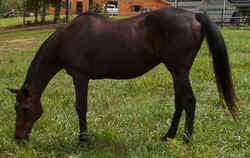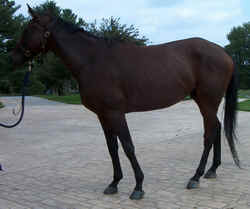 |
 |
Thoroughbred
 |
 |
Perhaps the horse most known around the world is the Thoroughbred. Since its development, horse racing, which has existed for thousands of years, was brought to an entirely new level. The Thoroughbred is the fastest horse in the world over long distances. As the sport of Thoroughbred racing gained in popularity, Thoroughbreds were exported worldwide. The Thoroughbred can cover a mile at nearly 40 mph! They are supreme racing machines, and to stand on the edge of a track watching a group of racehorses thunder by is absolutely inspiring. The ground vibrates with the pounding of hooves, and the air is electric with the energy used to maintain the speed of the surging horses. Their jockeys cling to their backs like small, brightly colored beacons in a stormy sea of flying horse power. The lineage of modern Thoroughbreds can be traced back to all or one of the three great foundation sires of the breed. The Darley Arabian, the Byerley Turk and the Godolphin Barb (often referred to as an Arabian) were all imported to England during the late 17th and early 18th centuries and crossed with native mares. There are different types of Thoroughbreds according to the distances run. Sprinting races require a horse that is quick at the start, and so sprinters, needing to generate great speeds over short distances, are more compact and shorter than the longer distance runners. Long or middle distance race horses need stamina and endurance, and their tall, sleek physique and enormously long, ground-eating strides make it easier for them to cover more ground with less energy spent. Description: The modern Thoroughbred is a beautifully put-together horse. Its head is refined and expressive, with large eyes and medium-length ears; neck long and slightly arched, set into prominent withers and well-sloped shoulders; chest broad and girth deep to allow for greater heart and lung capacity; back short, with well-sprung ribs and muscular hindquarters; tail set high and croup gently sloped; legs strong, with length varying according to type; bone very dense and joints well developed, with flexible pasterns; hooves quite small and round, though tending to be brittle; skin very thin and fine; mane and tail fine and silky; color predominantly bay, brown and chestnut, but any solid color seen. [Grove, Kindrie, Field Guide to Horses, Lone Pine Publishing, Edmonton, Alberta, 1998]
Horses * Horse Books * Mules * Nature Lovers